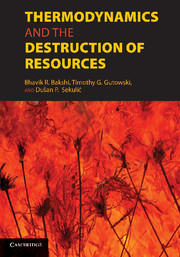Book contents
- Frontmatter
- Contents
- Contributor List
- Foreword by Herman E. Daly
- Foreword by Jan Szargut
- Preface
- Introduction
- PART I FOUNDATIONS
- PART II PRODUCTS AND PROCESSES
- PART III LIFE-CYCLE ASSESSMENTS AND METRICS
- PART IV ECONOMIC SYSTEMS, SOCIAL SYSTEMS, INDUSTRIAL SYSTEMS, AND ECOSYSTEMS
- 14 Early Development of Input–Output Analysis of Energy and Ecologic Systems
- 15 Exergoeconomics and Exergoenvironmental Analysis
- 16 Entropy, Economics, and Policy
- 17 Integration and Segregation in a Population – a Thermodynamicist's View
- 18 Exergy Use in Ecosystem Analysis: Background and Challenges
- 19 Thoughts on the Application of Thermodynamics to the Development of Sustainability Science
- Appendix: Standard Chemical Exergy
- Index
- References
17 - Integration and Segregation in a Population – a Thermodynamicist's View
Published online by Cambridge University Press: 01 June 2011
- Frontmatter
- Contents
- Contributor List
- Foreword by Herman E. Daly
- Foreword by Jan Szargut
- Preface
- Introduction
- PART I FOUNDATIONS
- PART II PRODUCTS AND PROCESSES
- PART III LIFE-CYCLE ASSESSMENTS AND METRICS
- PART IV ECONOMIC SYSTEMS, SOCIAL SYSTEMS, INDUSTRIAL SYSTEMS, AND ECOSYSTEMS
- 14 Early Development of Input–Output Analysis of Energy and Ecologic Systems
- 15 Exergoeconomics and Exergoenvironmental Analysis
- 16 Entropy, Economics, and Policy
- 17 Integration and Segregation in a Population – a Thermodynamicist's View
- 18 Exergy Use in Ecosystem Analysis: Background and Challenges
- 19 Thoughts on the Application of Thermodynamics to the Development of Sustainability Science
- Appendix: Standard Chemical Exergy
- Index
- References
Summary
Introduction
When resources become exhausted – for whatever reasons – dearth and starvation occur. Impending crises of that sort are foreshadowed by sociological changes, and the oft-deplored phenomenon of segregation of sociological groups is one of them. However, that phenomenon may not be only a random concomitant of an economic crisis: Like a fever in an infected body, when a sick body runs a temperature, segregation may be a symptom that shows that the society is trying to survive and that it makes the best of a bad situation in expectation of better times.
Social behavior is largely dictated by the competition of sociological groups for a limited amount of resources, essentially and ultimately food. Such groups may represent social classes, or ethnic and racial groups, or religious sects, etc.
If resources are abundant and consequently prices are low, the competition is more or less friendly and relaxed, and there is room and occasion for social niceties and tolerant conduct between sociological groups. Granted that there is always competition, yet in times of abundance the competitive strategy is dictated by good will and a population finds it easy to integrate members of different groups.
When resources are scarce and therefore expensive, the competition becomes more serious, or even fierce. A new strategy – a more competitive one – may be employed by all sociological groups, and the mutual tolerance between groups is strained or altogether abandoned. Those are the conditions under which segregation occurs in a population.
- Type
- Chapter
- Information
- Thermodynamics and the Destruction of Resources , pp. 429 - 452Publisher: Cambridge University PressPrint publication year: 2011



